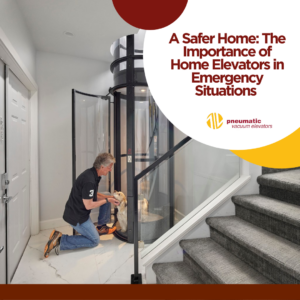
Firstly, residential lifts are designed with a comprehensive set of safety features to ensure the well-being of occupants during transit. So, these features encompass various aspects of the lift’s operation and emergency response mechanisms.
Emergency Braking for Swift Response
One of the critical safety features in modern residential lifts is the emergency braking system. So, this system ensures a swift and controlled stop during malfunctions or power outages, prioritizing passenger safety above all.
Smart Sensors for Enhanced Safety in Residential lifts
The integration of smart sensors is a key safety measure in residential lifts. Also, these sensors actively detect obstructions in the door path or the lift cab, contributing to accident prevention and ensuring the safety of passengers.
Automated Communication for Prompt Response
Residential lifts feature automated communication systems for emergencies. This ensures that, in critical situations, immediate contact with emergency services is established, facilitating a rapid response to any unforeseen events.
Summary:
- Swift and controlled stops during malfunctions or power outages.
- Detection of obstructions, ensuring accident prevention.
- Real-time contact with emergency services for prompt assistance.
Structural Integrity and Load Capacity
Safety in residential lifts extends beyond operational features to the structural integrity of the lift system. So, understanding load capacity limits and how lifts are engineered for robustness provides insight into the overall safety of these systems.
Load Capacity Limits for Safe Operation: Safety in Residential lifts
Respecting load capacity limits is fundamental for the safe use of residential lifts. However, Safety in Residential Lifts emphasizes the importance of adhering to these limits to prevent overloading and maintain the safety of occupants.
Structural Durability and Long-Term Safety in Residential lifts
The structural durability of residential lifts is a key factor in long-term safety. So, exploring the materials and construction methods highlights how these lifts are designed to withstand regular usage and unforeseen stresses.
Summary:
- Load Capacity Limits: Adhering to specified limits is crucial for safe operation, preventing overloading and potential hazards.
- Structural Durability: Materials and construction contribute to structural durability, ensuring lifts can withstand regular use and unexpected stresses.
Fire Safety Measures in Residential Lifts
Fire safety is a critical aspect of residential building design, and lifts are no exception. This section delves into the specific fire safety measures incorporated into modern residential lifts.
Fire-Resistant Materials for Safety in Residential lifts
The use of fire-resistant materials in lift construction is a proactive measure to reduce the risk of fire-related damage. This section highlights how these materials contribute to enhanced safety during emergencies.
Automatic Recall Systems during Fire Alarms
Automatic recall systems play a crucial role in fire safety. When a fire alarm is activated, these systems ensure that the lift moves to a predetermined safe floor, facilitating the safe evacuation of passengers.
Summary:
- Fire-Resistant Materials: Components of residential lifts are often constructed using fire-resistant materials, reducing the risk of fire-related damage.
- Automatic Recall Systems: In the event of a fire alarm activation, lifts are equipped with automatic recall systems, moving the lift to a designated safe floor for passenger exit.
Accessibility Features for Inclusive Safety
So, ensuring inclusivity in residential lifts involves incorporating accessibility features. Therefore, this section explores how these features contribute to the safety and usability of lifts for individuals with diverse mobility needs.
Inclusive Controls for Diverse Mobility Needs: Safety in Residential lifts
The accessibility of controls is a key consideration for inclusive safety. It is one of the pinnacles of comfort and peace of mind for people with disabilities or the elderly. Therefore, The inclusion of these accessible controls would allow full control of all users of our residential lifts.
Spacious Cab Design for Comfortable Transit
At PVE Home Lifts we think of everyone’s needs, that is why we have designed lifts from the smallest for one person to two people. Therefore, we created a bigger lifts, so the spacious design of these is intentional, especially to accommodate wheelchair users.
Summary:
- Accessible Controls: Lifts feature controls that are accessible to individuals with mobility challenges.
- Spacious Cab Design: The design of the lift cab itself is geared towards providing ample space for wheelchair users and ensuring comfortable entry and exit for all passengers.
Regular Maintenance Protocols
Maintenance is the backbone of Safety in Residential Lifts. So, this section delves into the importance of regular maintenance protocols, ensuring that lifts operate at peak performance and safety levels.
Scheduled Inspections for Early Issue Identification: Safety in Residential lifts
Also, regular inspections are crucial for early identification of potential issues. So, scheduled inspections contribute to preemptive issue resolution, maintaining lift safety.
Adherence to Manufacturer Guidelines in Maintenance: Safety in Residential lifts
So, strict adherence to manufacturer guidelines is a cornerstone of lift maintenance. Therefore, follow these guidelines ensuring that is aligned with industry standards.
Summary:
- Scheduled Inspections and Servicing: Lifts undergo scheduled inspections and servicing to identify and address potential issues before they compromise safety.
- Maintenance teams adhere to strict manufacturer guidelines, ensuring that servicing is conducted according to industry standards and best practices.
Residential lifts are a testament to engineering innovation, offering not only convenience but a myriad of safety features. As residents continue to embrace vertical living, understanding these safety features becomes paramount for fostering a secure and confident community. Lifts are not just a means of ascent and descent; they are a commitment to safe, seamless, and inclusive vertical transit.
FAQ: Frequently Asked Questions
Q1: Are residential lifts safe for use?
A: Yes, in regards of Safety in Residential lifts, these are equipped with advanced safety features such as emergency braking systems. Also, smart sensors, and fire safety measures, ensuring secure transit for occupants.
Q2: How lifts are maintained for long-term safety?
A: Lifts undergo scheduled inspections and servicing adhering to strict manufacturer guidelines. So, regular maintenance protocols are in place to identify and address potential issues before they compromise safety.

